Listen to Understand, Not to Reply: The Art of Empathetic Listening
In our fast-paced world, communication often feels like a race to be heard, rather than a chance to truly connect. We interrupt, formulate our responses while others are still speaking, and miss the nuances of genuine conversation. Mastering the art of "listening to understand, not to reply" is a crucial skill for building stronger relationships, resolving conflicts effectively, and fostering deeper understanding in all aspects of life. This isn't just about hearing words; it's about absorbing meaning, emotions, and perspectives.
This article will delve into the power of empathetic listening, exploring its benefits, common barriers, and practical strategies to cultivate this valuable skill. We'll also address frequently asked questions to provide a comprehensive guide to becoming a more effective listener.
What are the benefits of listening to understand?
The benefits of prioritizing understanding over formulating a response are numerous and far-reaching. Improved communication is the most obvious benefit, leading to stronger relationships, both personal and professional. When people feel truly heard and understood, they are more likely to open up, share their vulnerabilities, and collaborate more effectively. This creates a more positive and productive environment. Furthermore, active listening fosters trust and empathy, creating a sense of connection and mutual respect. It also reduces misunderstandings and conflicts, allowing for more constructive problem-solving. Finally, empathetic listening helps us gain valuable insights into others' perspectives, broadening our understanding of the world and enriching our personal growth.
How can I improve my listening skills?
Improving your listening skills requires conscious effort and practice. Firstly, focus on being present and minimizing distractions. Put away your phone, find a quiet space, and give the speaker your undivided attention. Secondly, practice active listening techniques, such as maintaining eye contact, nodding to show understanding, and reflecting back what you've heard to ensure accurate comprehension ("So, it sounds like you're feeling frustrated because..."). Thirdly, be mindful of your body language. Avoid interrupting, fidgeting, or displaying signs of impatience. Finally, practice empathy by trying to understand the speaker's perspective, even if you don't agree with their viewpoints. Consider their feelings and the context of their message.
What are some common barriers to effective listening?
Several factors can hinder our ability to listen effectively. Preconceived notions and biases can cloud our judgment, preventing us from objectively hearing what's being said. Our own emotional responses can also interfere, causing us to become defensive or reactive. Distractions, both internal (e.g., racing thoughts) and external (e.g., noisy environments), can significantly impair our listening abilities. Furthermore, a preoccupation with formulating our response before the speaker has finished can prevent us from fully grasping their message. Finally, a lack of patience can lead to impatience and interrupting the speaker before they have had a chance to express themselves fully.
How is listening to understand different from just hearing?
Hearing is a purely physiological process – the reception of sound waves by the ear. Listening, however, is a cognitive process that involves actively processing and interpreting the information received. It includes paying attention, understanding, remembering, evaluating, and responding. Listening to understand goes beyond merely hearing the words; it involves attempting to grasp the speaker's meaning, emotions, and intentions. It requires empathy and a willingness to see things from the speaker's perspective. Hearing is passive; listening to understand is active and engaged.
Why is it important to listen without interrupting?
Interrupting demonstrates a lack of respect and undermines the speaker's confidence. It prevents them from fully expressing their thoughts and feelings, and can lead to misunderstandings and conflict. When we interrupt, we signal that we value our own thoughts and opinions more than the speaker's. By allowing the speaker to finish without interruption, we create a safe and supportive environment where they feel comfortable sharing their perspectives openly and honestly. This fosters trust and deeper connection. It shows that we value their contribution to the conversation and that we are genuinely interested in understanding their point of view.
How can I tell if I am listening to understand or just to reply?
Self-reflection is key to identifying whether you're listening to understand or simply waiting for your turn to speak. If you find yourself formulating your response while the speaker is still talking, or if you're primarily focused on how you will react rather than what is being said, then you're likely listening to reply. If, on the other hand, you are genuinely curious about the speaker's perspective, are asking clarifying questions, and summarizing their points to ensure understanding, you are actively listening to understand.
By consciously practicing these techniques and cultivating self-awareness, you can transform your communication style and reap the profound rewards of empathetic listening. It's a journey, not a destination, but the investment in improving this essential life skill will yield significant returns in all areas of your life.
